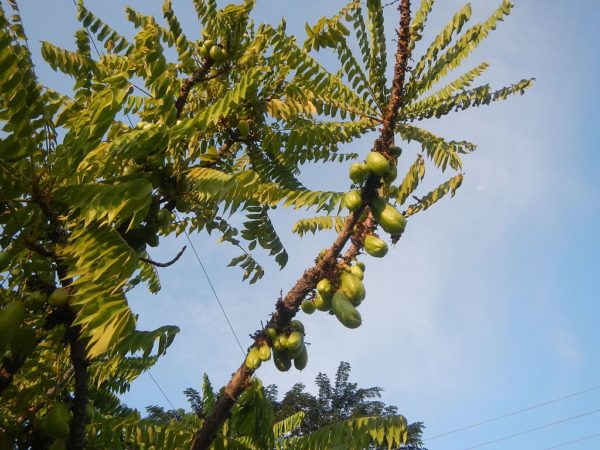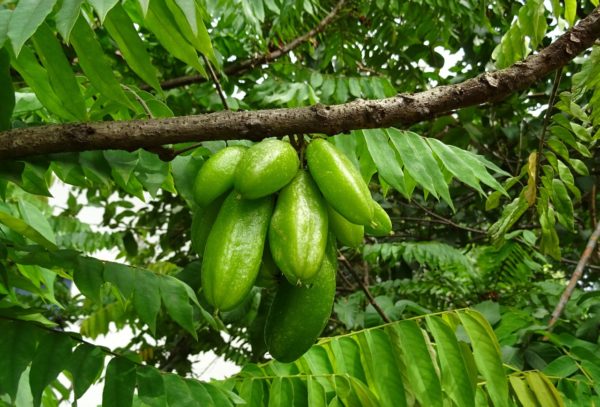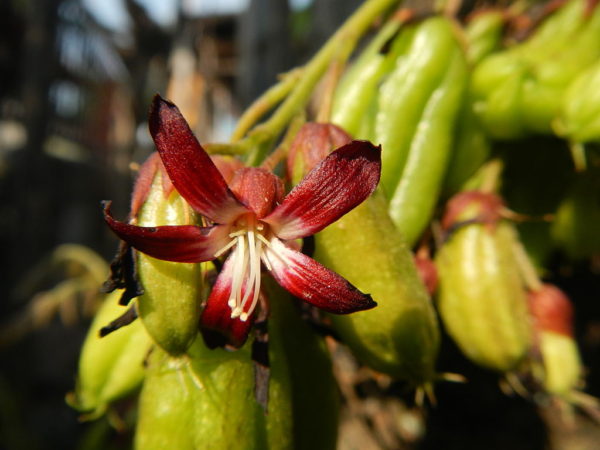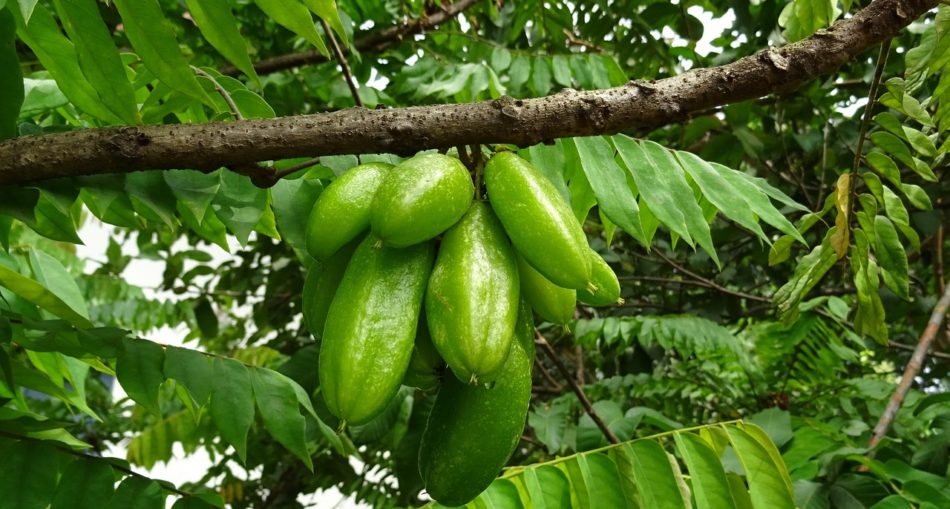When you think of fruits, immediately the thoughts of fresh sweet, tangy delectable items come to mind. But, did you know that there is one fruit that is sour when eaten fresh? This fruit is commonly known as in Guyana as sourie, bilimbi or kamranga. The scientific name of this fruit is Averrhoa bilimbi. It is a fruit-bearing tree of the genus Averrhoa, and belongs to the family of Oxalidaceae. In Guyana, it is usually used to make ‘achar’ or pepper sauce, added to fish curry or more commonly used to make a delicious ‘sour’ or chutney to accompany a range of fried food items such as phulourie, egg balls, boiled channa, etc.
- Kamranga was first cultivated in Jamaica in the Caribbean, from where it cultivation then spread to Central and South America.

Kamranga Tree – Photo By Judgefloro [CC0]
Culinary Uses of Kamranga in Guyana
- Curries – When added to curries, such as fish and shrimp, Kamranga adds a nice tangy flavour but Kamranga can be made into a curry on its own.
- Sours/Chutneys – It can be used as a replacement for mangoes when making these sours and chutneys for those persons who don’t have mangoes at the moment or simply love the taste of Kamranga sour!
- Kamranga Achar – This tasty condiment can be eaten with almost anything!
Kamaranga Curry Recipe
Ingredients
- 500 g/1 lb bilimbi fruit
- 2 teaspoons salt
- 2 tablespoons oil
- 1 medium onion, finely chopped
- 2 fresh pepper
- 1/2 turmeric
- 2 teaspoons roasted ground coriander
- 1 teaspoon chilli powder or to taste
- 125 ml/4 fl oz/1/2 cup coconut milk
- 1 teaspoon salt or to taste
Directions
- Wash and slice kamranga, put into a bowl with water covering it.
- Stir two (2) teaspoons of salt and leave for about thirty (30) minutes.
- Rinse kamranga and and squeeze moisture.
- Heat oil and fry seasoning and onions. Add pepper, turmeric, coriander and chilli powder and fry for one minute.
- Add kamranga, fry and stir for five (5) minutes.
- Then add coconut milk and salt. Let it simmer uncovered until the mixture is thick and oily. Serve with rice.
Kamranga Sour/Chutney

Kamaranga – Image Source https://www.needpix.com/photo/download/748643/bilimbi-fruit-averrhoa-bilimbi-cucumber-tree-tree-sorrel-tree-averrhoa-oxalidaceae-flora
Ingredients
- ½ lb Kamranga fruit
- 1/8 lb Pepper
- 5 Cloves Garlic
- A pinch Salt
Method:
- Wash kamranga fruit and pepper.
- Slice kamranga fruit in half.
- Cut pepper in quarters.
- Heat half pot water.
- Add kamranga and pepper into pot.
- Add the garlic.
- Boil until tender on low heat.
- Take a fork and mash kamranga fruit and pepper.
- Let it cool and enjoy it with some phulorie or an eggball.
Kamranga Achar Recipe
Ingredients:
- Kamranga
- Achar Masala
- Pepper
- Oil
- Salt
- Garlic
Pre-Preparation:
- Wash and cut the tip and bottom of the Kamranga fruit off.
Method:
- Grind garlic and pepper together.
- Heat oil in pot.
- Add garlic and pepper mixture to oil and sauté for a few minutes.
- Add Kamranga fruit and mix thoroughly.
- Add salt to taste.
- Lower the heat of the fire.
- Stir every few minutes.
- Cook until Kamranga fruit is tender.
Interesting Tips:
- Kamranga Pepper Sauce- In addition to being used to make the traditional ‘grind’ pepper sauce, the kamranga fruit can also be boiled or steamed with the pepper and salt to make tasty pepper sauce.
- The Kamranga fruit can be eaten raw with salt.
Health Benefits of eating Kamranga

The Kamranga Flower and Fruit – Photo By Judgefloro [CC BY-SA (https://creativecommons.org/licenses/by-sa/4.0)]
- Control Diabetes – Kamranga fruits are known to reduce blood sugar level. They can either be made into juice or boiled with water and then drunk.
- Antibiotic Effect – Sap from young stems and the leaves of the Kamranga plant can be used to reduce swelling, rheumatism, itch, and insect bites. Young stems and leaves should be mashed with three (3)-(4) cloves of garlic and made into smooth paste which is then applied to the affected area of the skin.
- Treatment of Allergies – Drinking fruit juice made from Kamranga fruit or leaves infusion regularly helps to reduce the allergies.
- Control Hypertension – Boiled with water and then drunk, the Kamranga fruit can be used to control blood pressure.
- Reduce Fever and Flu – The Kamranga flower can be made into infusion for treating cold and cough. The high vitamin C in this fruit helps strengthen immune system.
- Swollen Joints – Paste prepared from Kamranga leaves is highly effective for dealing with joints that are swollen, stiff and achy.
- Treatment of Obesity – Kamranga fruits can be used as a traditional medicine to control obesity. People think that Kamranga fruit contains anti-hyper-lipidemic agents, so it can prevent weight gain.
Interesting Tips:
- Kamranga is known by many names around the world. For example, ‘mimbro’ in Central and South America and ‘lange birambi’ in Suriname.
- Kamranga is also referred to as ‘tree sorrel, ‘cucumber tree’, ‘bimbling plum’ and ‘pickle fruit’.
- The fruit can be preserved by drying in the sun or frozen.
- It can be used as a substitute for mango when there none.
- A paste made from the leaves of the Kamranga tree can be used to treat insect bites.
- The wood from the Kamranga tree can be used for making furniture.
- Crushed Kamranga fruit can be used to bleach and get rid of stains from clothes without changing their colour.
- Kamranga trees can also be grown in areas with temperate climate but requires more care.
- The fruit is also used in some countries to make wine.
The Kamranga fruit may not be as well-known as other fruits but it has many useful purposes. Especially here in Guyana and the Caribbean, its benefits are being made full use of. Next time you visit your local market, do keep your eye out for this fruit and try it out if you haven’t already! The sour is especially mouthwatering when eaten with bowl of phulourie or boiled channa.
Read one of our previous article to find out more about Kamranga or Sourie: https://www.thingsguyana.com/bilimbi-locally-known-as-soury/
Article References
- https://www.healthbenefitstimes.com/bilimbi/
- http://tropical.theferns.info/viewtropical.php?id=Averrhoa+bilimbi
- https://en.wikipedia.org/wiki/Averrhoa_bilimbi
Date First Published: 2020-02-03
Date Last Edited: 2020-02-03







